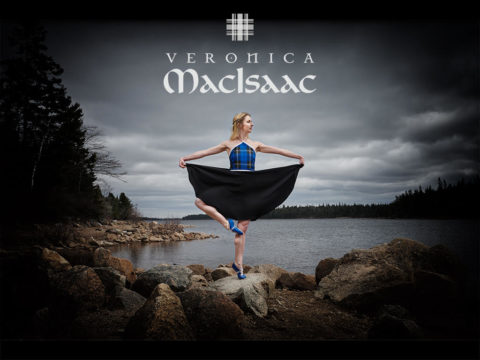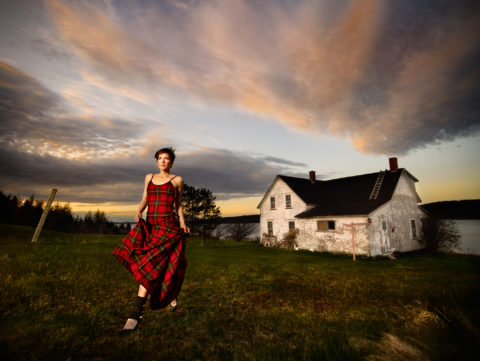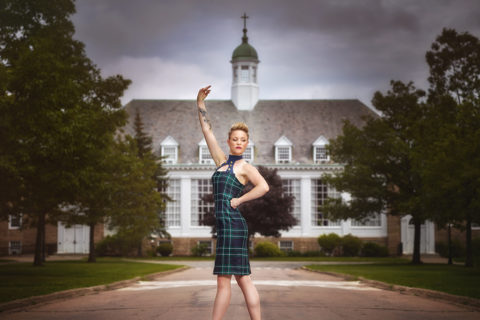We Chat With Veronica MacIsaac, The World’s Only Tartan Fashion Designer
This one is for all you Claire Fraser wannabes...
You might say Veronica MacIsaac was fated to be a tartan fashion designer.
Born of Scottish descent to parents on Celtic Cape Breton Island, her mother went into labour with her at a pipe band party. Today she is known world’s only fashion designer who specializes in women’s modern tartan clothing. Based out of Halifax, Nova Scotia, MacIsaac gets customers from across Canada, Scotland and beyond. (And no, she’s not related to fellow Cape Bretoner Ashley MacIsaac.) In honour of National Tartan Day, we caught up with her to discuss her career, the A-listers she’s come into contact with, and the crucial difference between plaid and tartan.

How did tartan became a part of your life?
It has been a part of my life since I was born. My great-grandfather played the bagpipes and he piped the troops onto the battlefield in World War I, so it has been a big part of our lives for generations. My brother was surrounded by bagpipes and I took highland dancing lessons. My brother still to this day is a piper. That is what he does for a living.
When I was really little I had a little kilted skirt that a lot of my cousins had worn, it was passed down through the family. When I was about seven, I outgrew it so my mom, who has a textiles degree from StFX, and was always a seamstress, decided that she was going to make kilts. She started MacIsaac Kiltmakers, which is now a big internationally known kilt-making company. But originally, it was just because I needed a new kilt for highland dancing.
So what is the difference between plaid and tartan?
Tartans have been around for several hundred years, and each tartan denotes a clan, a family group, a place, a military service. It is a very specific thing. There is a tartan registry board. It has all that information, and it has exactly how many threads each colour cross each other, it’s all very regulated. In the U.K., plaid is actually a garment — it’s something that you wear. But in North America the term “plaid” is just crossed checkered fabric. However, people use it all the time incorrectly. I cannot tell you the amount of times in articles and newspapers they use the term “mad for plaid” and that drives me crazy, it’s not correct. To boil it down, all tartans are plaid. But not all plaids are tartan.

Is there a big market for your work as a tartan designer?
As an independent fashion designer, if you don’t have a real solid niche it is a really tough industry to break into. However, because I have this super specific niche, I think a lot of people are surprised that I can make a living making tartan clothing, but I do. It is my full-time job. Because it is so niche it is really easy to market towards. Because I am the only one in the world that does what I do, it makes it that much easier. I can just target any of the Scottish communities in the world and I am the one person doing it. It makes it a little easier that way. So far I am surprised that no one else is doing it. I am still the only one.
What kind of designs are you creating out of tartan?
A lot of designers have a really really specific aesthetic and the thing that is always constant with me is the tartan. I try and switch it up a lot. I can’t keep making the same shape in tartan because that will always look the same. I do like things to be fairly structured. I take a lot of inspiration from the ‘40s, ‘50s, ‘60s; those are my favorite eras of fashion, so I definitely lean into that a little more. But I have done everything from tartan lingerie to gowns to baby clothes.
Who are your clothes for?
My whole main thing is I want to create clothing for people who want to wear their own personal style, but in a heritage fabric. If somebody would normally wear a pencil skirt, it would be a tartan pencil skirt in their family tartan. A style they would actually wear. I try to have a variety of styles that suit different body shapes, different heights and different ages.
Have you ever had any A-list or famous customers?
There is an annual event in New York called Dressed To Kilt and Sean Connery was the chairman of the show when it first started. I went down and did it for two years in a row, and all the models in the runway show are celebrities and TV stars and newscasters and sports stars. I did meet and dress a lot of stars in that way, but not I don’t have any famous personal customers I would say. There are a lot of A-listers inside the Scottish community, but that’s not quite the same.
What has been the proudest moment in your career?
I did a photoshoot in Soldiers Cove, Cape Breton, with my cousin Marsalie on our family’s homestead where our grandmother grew up, and her father and his father; it had been in our family for a couple hundred years and isn’t inhabitable anymore. She is wearing my McQueen tartan gown, which is my favorite piece that I have ever designed or created. The photo is incredible. It got published on the Italian Vogue website, and then it was published in print in British Vogue later that year. My cousin Marsalie, the model, is an officer in the Canadian Navy. She found out she was winning a Navy medal the same day she was going to be in British Vogue. I thought, “How cool is that?” There can’t be many navy officers that are also models. So I guess that was more for her than me, but still, being in British Vogue, that was pretty great.

What does working with something that is so rooted in your background and culture mean to you?
I have a lot of friends in the entrepreneur community and they don’t understand why I still do this. To them, it would make more sense to have my stuff massed produced, it would make more sense to just a line with stock tartans and have it be easier on me. But to me, wearing your tartan is a sense of pride and a sense of heritage and history. I’ve always known what my background is, what my heritage is and what my history is, so to me it is just wearing the tartan that multiple generations of people before me wore. I think that’s an important thing.
What’s the best part of your job?
There is something so lovely to me about finding a customer and have them come to me and say “I know I am Scottish but I don’t know what my tartan is or what it looks like.” And when I show the tartan to them, that look on their face of “oh wow this represents so much of my history.” I love seeing that in people.
Tartan is not just a fabric, it is something of great historical significance in Scotland. Scotland has had a lot of trouble and strife over the years and for 37 years in the 1700’s, the English government banned tartan from being worn because they were trying to squash the highland clan system. If you were caught wearing it, your first offence you were jailed for six months, your second offence you were jailed for seven years. So, the Scotsmen never wanted to stop wearing their tartans, so they would wear it underneath other garments.
It’s not just that tartan is pretty and has pretty colours. To me it’s more than that. It’s about resilience, and keeping your values, and keeping that heritage strong and passing it on to the next generation.








